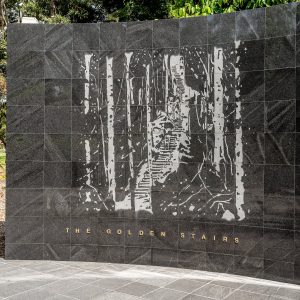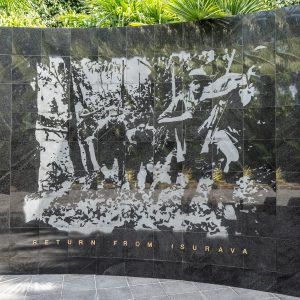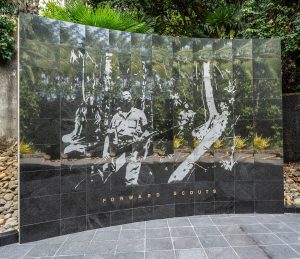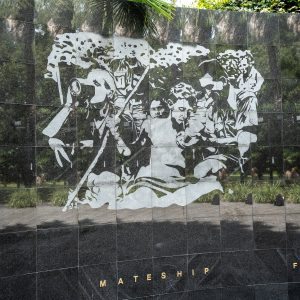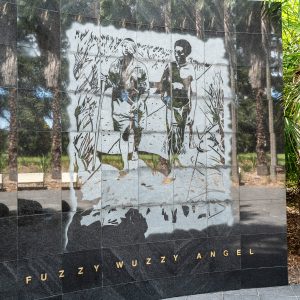Our beautiful Memorial Centrepiece is the tranquil heart of the Walkway.
The five iconic images sandblasted onto the Centrepiece walls each tell a story of the courage, endurance, mateship and sacrifice of the Australians who fought in the campaign.
Construction of the Walkway and Centrepiece began in late 1995, and the first stage was opened in October 1996. Since then, the Centrepiece has become the living, breathing heart of the Walkway, and is the location for our commemorative and wreath laying services.
Please visit the Centrepiece next time you’re at the Walkway, but remember the Centrepiece and the Walkway itself is a war memorial, so please treat it with respect.
The Memorial Centrepiece pays homage to those who served in the Kokoda campaign.
ICONIC IMAGES ON THE MEMORIAL CENTREPIECE
The Golden Stairs
The infamous ‘Golden Stairs’ was an obstacle that few of the troops who encountered it could easily forget as they headed to Imita Ridge. It consisted of some 2,000 timber steps cut into the mountain side by the engineers. It was an exhausting climb, followed by an even steeper descent.
Each step was battened at its edge by a rough log. These were sometimes broken and therefore treacherous, cradling mud and water from afternoon rains. In climbing the stairs, soldiers had to lift their leg over the log and put their foot down on the step behind in what was frequently a puddle of mud and water up to six inches deep.
The Golden Stairs have come to symbolise the endurance and courage needed by the Australians as they marched towards the advancing Japanese forces.
Return From Isurava
This iconic image is taken from Damien Parer’s famous Kokoda Front Line! documentary. Isurava was the scene of fierce fighting in mid-August 1942, as Australian troops consolidated their positions following a fighting withdrawal from Deniki.
This image shows members of the 39th Battalion returning to their camp after engaging the enemy at Isurava. Parer’s film highlighted the tough and demanding conditions the Australians faced against a determined Japanese advance.
This image reflects the endurance, courage and sacrifice of the Australians in these treacherous conditions.
Forward Scouts
Fighting the enemy in the thick, mountainous terrain was dangerous and nerve-wracking. The Forward Scouts image shows a group of Australian troops undertaking forward scouting duties.
The thick jungle allowed the Japanese troops to successfully merge into the jungle, often waiting to ambush the Australians among the dense ground cover. However, the Australians soon learned that individual enemy troops would conceal themselves high in the thick foliage, having climbed into the canopy where they lay in wait for days, with only meagre rations to sustain them.
This image reflects the courage, endurance, mateship and sacrifice of the Australians.
Mateship
Mateship is another image from Damien Parer’s film, and shows a scene where the famous Salvation Army Chaplain Albert Moore lighting a cigarette for a wounded Australian.
Moore and his fellow Salvation Army peers, together with volunteers from other groups such as the YMCA provided much-needed comfort supplies to the exhausted troops before and after frontline action. Although an unarmed non-combatant, Moore faced the same conditions as the troops, and won widespread praise for his efforts throughout the war years.
This image not only denotes mateship, but also the endurance and courage of all who saw service along the Track.
Fuzzy Wuzzy Angels
The assistance given to the Australian forces (and later the Americans) by native New Guineans and Papuans (‘Fuzzy Wuzzys’) during the PNG campaigns cannot be underestimated.
This iconic image (taken by George Silk) has come to define many of the aspects of the New Guinea campaign. Here Private George C. ‘Dick’ Whittington is being helped along a track through the kunai grass towards a field hospital on Christmas Day 1942, being assisted by Raphael Oimbari.
Natives helped carry supplies, they carried wounded back to aid stations, while others were in armed battalions. During the Kokoda campaign, they won universal praise from the Australians, but they too suffered from the elements and the dangers of Japanese attacks.
This image aptly defines the mateship, endurance, sacrifice and courage faced by all who served during the campaign.
SUPPORT THE WALKWAY
The Walkway’s success is dependent on the goodwill and services of many volunteers. You may wish to support the Walkway by becoming a volunteer, joining the Friends of Kokoda or by donating
SUPPORT US